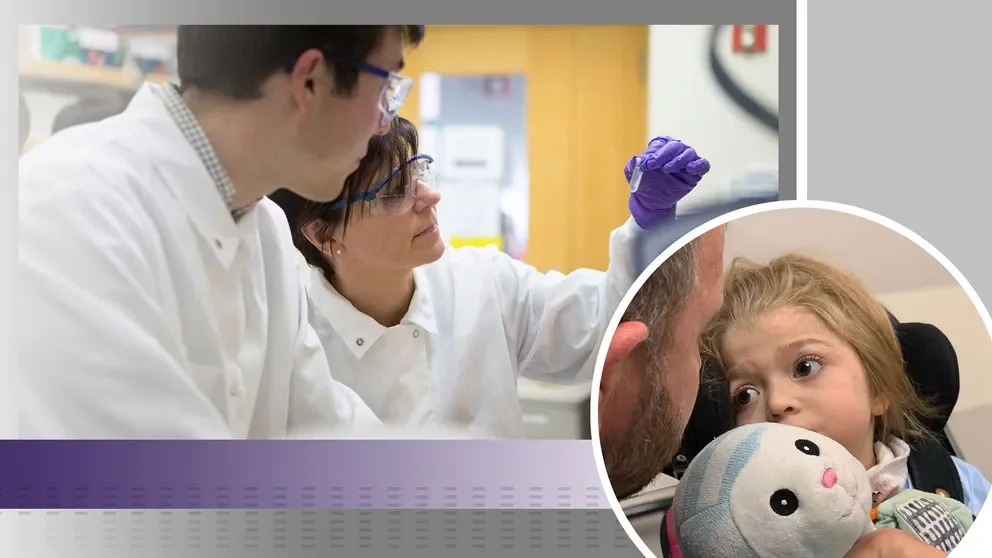Help for the smallest and rarest
The Search Magazine Article | February 23, 2021
Amber Olson is fighting for her daughter’s life. Olson is the mother of Willow, a 9-year-old diagnosed with an extremely rare genetic disorder, multiple sulfatase deficiency (MSD). And as the founder and tireless fundraiser and activist for the United MSD Foundation, she has pushed for research into Willow’s condition.
In 2017 the foundation came to the attention of Cat Lutz, Ph.D., director of the JAX Rare and Orphan Disease Center at The Jackson Laboratory (JAX) in Bar Harbor, Maine. Lutz and her Center colleagues are among the world’s leading experts in using mouse models to develop and test new treatments for rare genetic diseases.
rare-and-orphan-disease-center
Mouse models of a genetic disease carry the same mutations as patients with the disease, and are essential to understanding the disease and tailoring treatments. The JAX team launched a project to develop gene therapy strategies and to test small molecules for the treatment of this disease. “We definitely feel a sense of urgency to help these kids,” Lutz says.
In December, Olson Tweeted a video of herself holding a giant check for $145,407, thanking donors to the United MSD Foundation. “We’re super-excited to be able to send this” to JAX, she said. “This is a big thing for us to be able to fund this much.”
Willow is confined to a wheelchair and is incapable of most voluntary movement. MSD involves defects in a gene, SUMF1, that result in insufficient production of enzymes known as sulfatases. Sulfatase enzymes are supposed to break down complex sugars and fats in the cell, but in MSD, the fats and sugars build up in the cell to toxic levels, damaging the body’s tissues and organ systems, including the central nervous and skeletal systems.
“MSD is a terrible regressive condition,” Olson says. “Willow used to be able to run and walk, but slowly the cells are dying throughout her body.” The day-to-day struggles of the Olson family were documented in A Brutal Clock, a 2018 Huffington Post article.
MSD is one of the rarest members of a group of about 50 rare diseases classed as lysosomal storage disorders (LSD), all involving enzyme dysfunction. “These lysosomal storage disorders are devastating,” Lutz says. “In many cases, the kids start out developing normally, but then they start to lose ground and then rapidly deteriorate. And that regression really takes its toll on families.”
Lutz and her colleagues have been studying MSD specifically for several years, in collaboration with Drs. Steven Gray and Rachel Bailey of UT Southwestern, and had developed several MSD precision mouse models, with genetic mutations that represented those in many of the patients.
One JAX MSD model has turned out to accurately represent Willow’s disease. “We were really fortunate,” Lutz says. “Sometimes the mouse models can be not as informative as we want —they may be healthier or sicker than the patient, and we have to correct for that, but in this case we were lucky.”
Tackling MSD and other lysosomal storage disorders involves amping up the production of the missing enzyme, basically tricking the gene into functioning normally. The JAX team has been screening drugs that have already been approved by the FDA to see if they restore enzyme production.
The team is now wrapping up preclinical studies of a new gene therapy, Lutz says, “and they look really good. The benefit has been all that we had hoped for and more. We see improvements in survival, enzyme function and pathology, even in correcting the vision problems that are seen in many kids with lysosomal storage disorders.”
She cautions that there are many hurdles to delivering any gene therapy to patients, including determining correct dosage, regulatory approvals and the high cost of clinical trials. And, her team including Research Scientist Max Presa, Ph.D., is exploring additional therapies such as bone marrow transplants that could boost the effectiveness of gene therapy treatments.
Olson recently shot a video by Willow’s bedside as a special message to JAX employees who have been caring for the MSD mice. “I just wanted to tell you we appreciate you so much, and you’re making a such a difference for these children. Someday when they’ll go to a clinical trial in a hospital, they’ll be treated and it will be because of you.”

